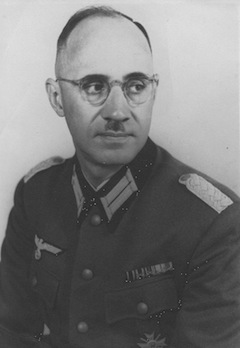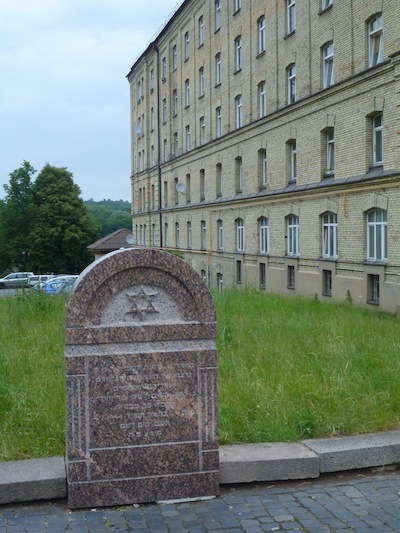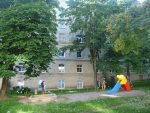One of the apartment buildings at the HKP complex. (photo from Richard Freund)
Nearly three-quarters of a century after the Shoah ended, we are still learning about aspects of what happened. For example, the documentary The Good Nazi tells the little-known story of a Nazi from Vilna who tried to rescue more than 1,200 Jews. It airs on VisionTV Jan. 21, and again April 29.
In 2005, Dr. Michael Good sought out Prof. Richard Freund of the University of Hartford to tell him about Maj. Karl Plagge, a Nazi who oversaw a military vehicle repair complex that was used as cover for 1,257 Jews in Vilnius (Vilna). Good described how his father, mother and grandfather were saved within this complex, and later wrote about it at length in his 2006 book The Search for Major Plagge: The Nazi Who Saved Jews (Fordham University Press).
While interesting to Freund, who works within a department known for its Holocaust studies, nothing further came of that meeting. That is, until 2015.
By then, Freund had directed six archeological projects in Israel and three in Europe on behalf of the university, including research at the extermination camp at Sobibor, Poland. In 2015, he was in Lithuania doing research on a Holocaust-era escape tunnel, adjacent to the Great Synagogue of Vilna. He and his team had brought with them specialized equipment that enabled non-invasive examination of the ground and walls, and they offered it to anyone wanting to do such research. The Vilna Gaon State Jewish Museum came calling, and brought Freund to a site on the outskirts of Vilna, where he was told about Plagge.

Of that moment, Freund told the Independent, “I’m sitting there and I say, ‘Karl Plagge? I know that name!’”
Freund connected with survivor Sidney Handler, who was 10 years old when he hid from the Nazis in the work camp. After the Nazis left in July 1944, Handler was forced to move dead bodies, and could point out decades later where 400 Jews were buried.
“We could have gone through the entire 20 acres and not located exactly where that was,” said Freund.
Using scanners, thermal cameras, radar and other methods, Freund’s team discovered and recorded the various hiding places, also called malinas. Under Plagge’s plan, Jews had built malinas in building crevices, behind the walls, to keep out of sight when Nazis came to “liquidate” the complex.
The garage (repair shop) was dubbed HKP. It was on Subocz Street and is likely the only Holocaust-related labour camp left completely intact. Until recently, people had been living in the two six-floor buildings, which comprised 216 apartments.
Freund reached out to filmmaker Simcha Jacobovici, telling him how important it was to document the site, the story, and reveal it to the world. Things were made all the more pressing when Freund and Jacobovici discovered that developers were going to demolish the site. Fortunately, before this happened, Jacobovici took a film and photographic crew to HKP, in January 2018.
The Turning of Plagge
In 1941, Karl Plagge was placed in command of the HKP 562, a unit responsible for repairs of military vehicles damaged on the eastern front. Plagge experienced something of a pang of conscience – he hadn’t signed on to genocide. He made the decision to leverage his position and use Jews as “slave labour” for HKP, pleading the case to his superiors that, if Jews didn’t work there, there would be no one to fix the vehicles.
Virtually none of the 1,200 Jews was knowledgeable in fixing cars; they were accountants, lawyers, hairdressers, academics, cooks and others. They all learned various HKP tasks on the job, and Plagge somehow convinced the Nazi SS that every single one of them was necessary for HKP.
Even though the entire charade was met with a barely tolerated wink and nod by Nazi brass, Plagge had a deep (and correct) hunch that their patience would eventually wear thin.
Heinrich Himmler, the head of the SS, announced, in the summer of 1943, that he wanted every Jew in Eastern Europe eliminated, irrespective of whether they were contributing to the war effort in a work camp. So, with Plagge’s approval, his workers carved out malinas in the walls of the buildings and in attic rafters.
As the Soviet Red Army approached the outer edge of Vilnius in June 1944, it was a sign that the Allies were nearing victory. In this context, on July 1, 1944, Plagge made an impromptu announcement in front of an SS commander and the Jewish workers, who gathered to listen. He explained that his unit was being transferred westbound and, though he requested his labourers be allowed to join, his superiors wouldn’t permit it. All of this was code for the Jewish prisoners to take cover. Roughly half of the workers – some 500 of them – hid away in malinas or ran from the camp, while others decided to stay.

When Nazi troops took over the camp two days later, 500 Jewish workers appeared for roll call, and were killed. It took the Nazis three more days to comb the camp and the surrounding area for any survivors, eventually finding roughly 200 Jews, all of whom were shot.
When the Soviets finally took over Vilnius later that week, approximately 250 of HKP’s Jews in hiding emerged.
When the war was over, Plagge returned home to Darmstadt, Germany, where, for the next two years he lived quietly, until he was brought to court as a former Nazi. Somehow, word traveled to a displaced persons camp in Stuttgart, a three-hour drive away, where many survivors of HKP had ended up. In Plagge’s defence, the survivors sent a representative to testify to the court in the hopes the charges would be overturned.
The testimony resulted in a favourable judgment, and Plagge received the status of an exonerated person. In 2005, after evidence and survivor testimony, Yad Vashem: The World Holocaust Remembrance Centre posthumously bestowed the title Righteous Among the Nations on Plagge.
The Good Nazi was produced in Canada for VisionTV by Toronto-based Associated Producers. Jacobovici was writer and executive producer, Moses Znaimer executive producer, Bienstock producer and co-director, Yaron Niski co-director and Felix Golubev line producer/executive producer.
Dave Gordon is a Toronto-based freelance writer whose work has appeared in more than 100 publications around the world.

